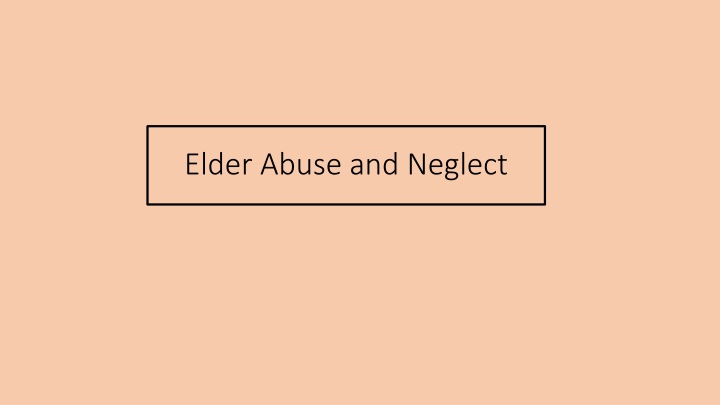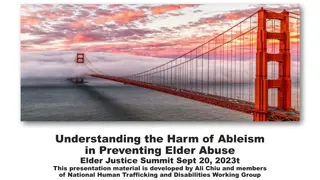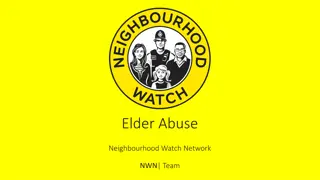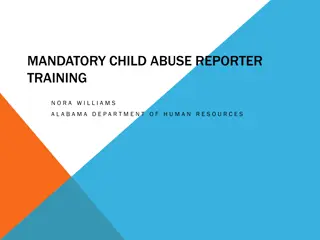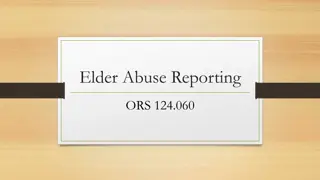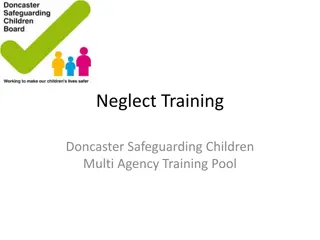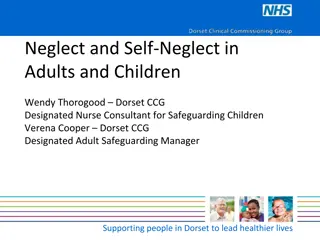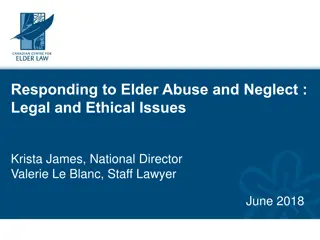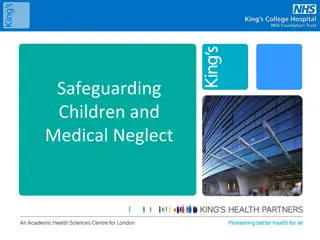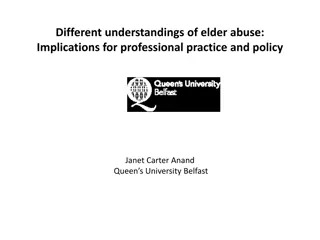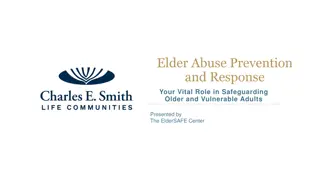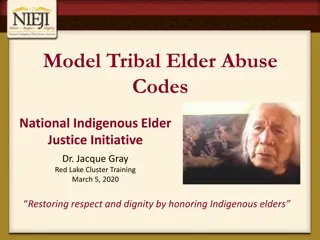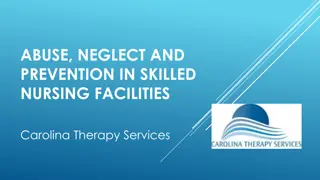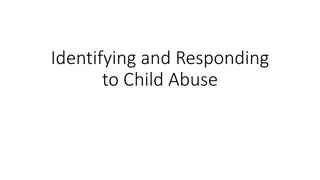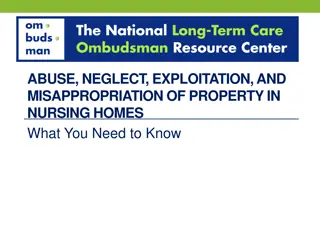Elder Abuse and Neglect
Elder abuse and neglect are serious issues affecting millions of Americans. This article delves into the various forms of elder abuse, including physical, emotional, psychological, material/financial abuse, neglect, and healthcare fraud. Signs and symptoms of possible abuse are highlighted, along with the devastating impact of elder abuse on the elderly population. It also discusses the prevalence of elder abuse and its connection to higher mortality rates.
Download Presentation

Please find below an Image/Link to download the presentation.
The content on the website is provided AS IS for your information and personal use only. It may not be sold, licensed, or shared on other websites without obtaining consent from the author.If you encounter any issues during the download, it is possible that the publisher has removed the file from their server.
You are allowed to download the files provided on this website for personal or commercial use, subject to the condition that they are used lawfully. All files are the property of their respective owners.
The content on the website is provided AS IS for your information and personal use only. It may not be sold, licensed, or shared on other websites without obtaining consent from the author.
E N D
Presentation Transcript
Elder Abuse: demographics, epidemiology Between 1 2 million Americans 65 years or older have been victim of mistreatment or neglect by caregiver National Elder Mistreatment Study estimates prevalence to be emotional (4.6 %), physical (1.6%), sexual (0.6%), financial (5.2%), and verbal (9%). Most common are children and spouses. Elder abuse thought to be linked to higher rates of mortality (Elder Abuse and Mortality: The Role of Psychological and Social Wellbeing X.Q. Dong,aM.A. Simon,cT.T. Beck,aC. Farran,bJ.J. McCann,a,bC.F. Mendes de Leon,aE. Laumann,dand D.A. EvansaGerontology. 2011; 57(6): 549 558. )
Forms of Elder Abuse Physical Emotional Psychological Material/ Financial Neglect Healthcare fraud/abuse
Physical Abuse Willful infliction on an elder person of physical pain or injury or unreasonable confinement It includes direct beatings, strangulation, sexual assault, unreasonable physical constraint Hitting, shoving, burning, restraining, scratching But physical findings are rarely found in primary care setting
AAFP: signs and symptoms of possible abuse Bruising in unusual locations (not over bony prominences; on lateral arms, face, or back; larger than 5 cm) Burns in patterns inconsistent with unintentional injury or with the explanation provided (e.g., stocking or glove pattern, suggesting forced immersion) Decubitus ulcers, unless the result of unavoidable decline Dehydration, fecal impaction Evidence of sexual abuse Intraoral soft tissue injuries Malnutrition, medically unexplained weight loss Missing medications, medications are not at therapeutic levels (not being administered or diversion) Patterned injuries such as hand slap or bite marks; ligature marks or scars around wrists, ankles, or neck suggesting inappropriate restraint Poor control of medical problems despite a reasonable medical plan and access to medication Subconjunctival or vitreous ophthalmic hemorrhage Traumatic alopecia or scalp swelling Unexplained fractures Unusual delay in seeking medical attention for injuries Urine burns (similar to severe diaper rash), dirty clothing, or other signs of inattention to hygiene
Material Financial Abuse The misuse of an elder s property or financial resources Includes financial deception, diverting income, mismanagement of funds, and taking money against a person s will Estimated 2.9 billion dollars per year involved in elder abuse Cognitive decline/changes increases vulnerability Scams
Psychological Abuse Conduct that causes mental anguish Verbal berating, harassment, or intimidation Threats of punishment or deprivation Isolation
Neglect Significant danger presented to an elder s physical or mental health when the person responsible for his or her care is unable to provide adequate food, shelter, clothing or medical/dental care Failure to meet basic needs of elder Most obvious signs are dehydration, malnutrition, temperature related injuries, and decubitus ulcers But neglect can occur without those signs
Health care fraud and abuse Not providing healthcare, but charging for it Overcharging or double-billing for medical care or services Getting kickbacks for referrals to other providers or for prescribing certain drugs Overmedicating or under medicating Recommending fraudulent remedies for illnesses or other medical conditions Medicaid fraud
Self-Neglect Diogenes syndrome (Senile Squalor Syndrome) Significant danger to an elder s physical or mental health because the elder is responsible for his or her own care, but is unable to provide adequate food, shelter, clothing or medical/dental care Up to 50% of reports to elder services are self neglect Persistent lack of essential self-care (e.g., inattention to personal hygiene, seriously unkempt appearance, hoarding) Persistent lack of cleanliness in the personal environment Lack of essential services and social support Personal behaviors that can lead to endangerment adult protective service agencies in all states accept referrals and investigate self- neglect
Older Adults at Risk History of Past Intergenerational Conflict Transgenerational violence asserts that violence is a learned behavior Elders who internalize blame Excessive loyalty on the part of the elder to the caregiver Medical, functional, or cognitive disability increases an older adult s risk for dependence and vulnerability Caregiver stress and psychopathology Women are more likely to be victims Increased dependency Isolation Alcohol Abuse Advanced Age
Caregiver Risk Alcohol or Drug Abuse Mental Illness (depression, anxiety) Socially isolated Poor self image The caregiver is young and immature The caregiver is forced by circumstances to care for a parent Financial dependency Lack of resources Who are they: Son (19%), Daughter (22%), Spouse (17%), Others (service provider, grandchild, friend/neighbor, other relatives)
Reporting Elder Abuse Although physicians and health care providers are mandated reporters in most states, less than a quarter of reports come from them In states with mandatory reporting and tracking, investigation rates are higher Most common referal are from: relative (20%), medical professional (17%), other provider (10%), social services (10%), law enforcement (9%). Friend/neighbor (7%) Health care professionals are required to report in all states when The victim reports the incident to you You observe the incident Injury is suspicious of abuse Some states require health professionals to report Actual or suspected abuse Abandonment Isolation Financial abuse Neglect
State Reporting Responsibilities Reporting laws vary by state Competent older adults have the right to Decide where and how to live Choose whether to accept social service or other community assistance Do not recommend victim leave if not ready It is estimated that only 1 in 5 cases of mistreatment cases is reported, and the proportion of reported cases of financial exploitation is even lower Financial Exploitation only about 1 in 25 cases are reported The many reasons people/providers do not report .
Connecticut Elder Abuse Reporting Requirements the willful infliction of physical pain, injury or mental anguish, or the willful deprivation by a caretaker of services which are necessary to maintain physical and mental health. Elder abuse also includes neglect, exploitation, and/or abandonment of an elderly (ages 60+) person. When any mandated reporter has reasonable cause to suspect or believes that someone age 60 or over (1) has been abused, neglected, exploited, or abandoned, or is in a condition caused by one of these or (2) is in need of protective services (services designed to protect elderly individuals from such harm), he/she must report this to the Connecticut Department of Social Services (DSS), Protective Services for the Elderly (PSE) within five calendar days. The report, which can be made orally or in writing, must contain the name and address of the elderly person, information regarding the nature and extent of the problem, and any other information which the reporter believes might be helpful in an investigation. the law grants both civil and criminal immunity to reporters in proceedings that might arise from the report, except for liability for perjury, unless the reporter acted in bad faith or with malice.
Documentation Chain of Evidence Precise and Thorough Description of the abusive event or neglectful situation Use of patient s own words whenever possible Complete Medical History Relevant Social History Detailed description of injuries An opinion on whether the injuries were adequately explained Pertinent labs or x-rays
Management Prevent Social Isolation Obtain home health services Attend adult day-care Expand social services Increase church activities or pastoral visits Decrease Caregiver Stress Enlist assistance from family members or friends Contact support groups Arrange for periodic respite visits Caregiver training
Management Manage Medical Issues Arrange substance abuse treatment (Al-Anon, AA) Manage depression Simplify medications Evaluate the home situation Perform home safety assessment Obtain necessary medical equipment Conduct capacity evaluation and need for guardianship Consider moving patient to higher level of care
Case Studies 73 yo female past med hx: HTN, CKD, dementia, TIA 93 yo male past med hx: T2DM, HTN, hyperlipidemia, GERD, cataracts, NSTEMI, vertigo 69 yo female, past med hx: COPD, HTN, depression/anxiety, chronic low back pain, hyperlipidemia, CHF
Bibiliography Balakrishnan, Kichu Nair. Geriatric Medicine: A Problems-Based Approach. Springer. 2018 Bhasin, Shalender, et al; Strategies to Reduce Injuries and Develop Confidence in Elders (STRIDE): A Cluster-Randomized Pragmatic Trial of a Multifactorial Fall Injury Prevention Strategy: Design and Methods; J Gerontol A Biol Sci Med Sci, 2018, Vol. 73, No. 8, 1053 1061 Ch etelat, Gael. Multimodal Neuroimaging in Alzheimer s Disease: Early Diagnosis, Physiopathological Mechanisms, and Impact of Lifestyle. Alzheimer s Disease: New Beginnings, G. Perry et al. (Eds.) IOS Press, 2018 Lee S Friedman Using clinical signs of neglect to identify elder neglect cases. J Elder Abuse Negl. 2017 Aug-Oct;29(4):270-287 Ganz, David et al. Prevention of Falls in Community-Dwelling Older Adults N Engl J Med 2020;382:734-43. Ham, Richard; Sloane, Philip; Warsaw, Gregg; Potter, Jane; Flaherty, Ellen. Ham s Primary Care Geriatrics: a Case Based Approach: Elsevier. 2014 Hampel, Harald, et al. Revolution of Alzheimer Precision Neurology. Passageway of Systems Biology and Neurophysiology Alzheimer s Disease: New Beginnings, G. Perry et al. (Eds.) IOS Press, 2018 Miller, Carol. Elder Abuse and Nursing. Springer, 2016 Neuroscience Blog. 7 Seven Stages of Alzheimers: 2020. https://www.pennmedicine.org/updates/blogs/neuroscience- blog/2019/november/stages-of-alzheimers Sloan, John. Protocol in Primary Care, Second edition. Springer. 1997 Solfrizzi, Vincenzo, et al. Nutritional Intervention as a Preventive Approach for Cognitive-Related Outcomes in Cognitively Healthy Older Adults: A Systematic Review. Alzheimer s Disease: New Beginnings, G. Perry et al. (Eds.) IOS Press, 2018 Zetterberg, Henrik et al, From Cerebrospinal Fluid to Blood: The Third Wave of Fluid Biomarkers for Alzheimer s Disease; Alzheimer s Disease: New Beginnings, G. Perry et al. (Eds.) IOS Press, 2018
